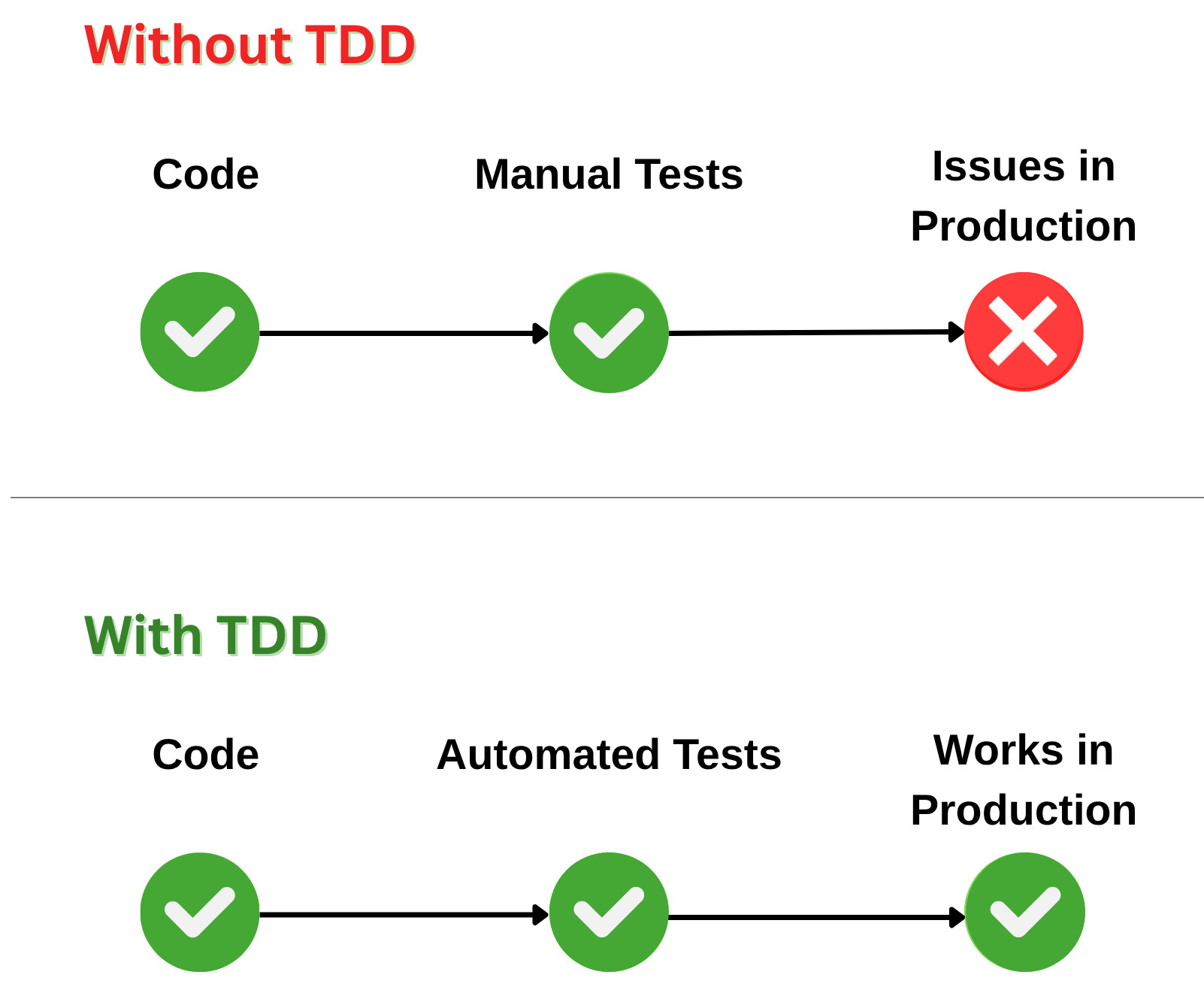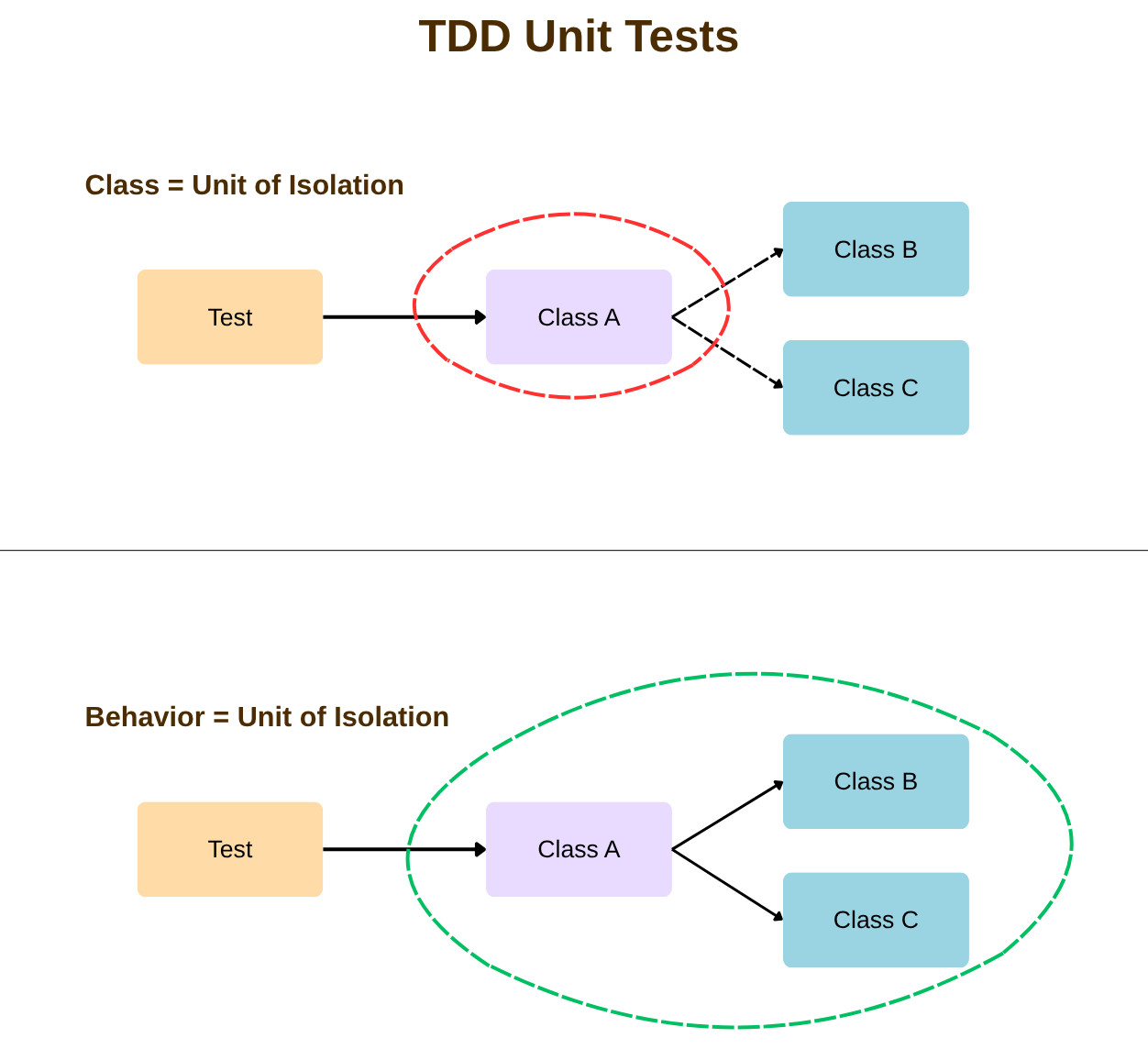What is Test Driven Development? TDD vs. BDD vs. SDD
|
|
| Key Takeaways: |
|---|
Benefits of TDD:
Pitfalls of TDD:
When Not to Use TDD:
|
What is TDD?
TDD is a software development practice driven by testing, combining coding and writing unit tests iteratively. TDD focuses on developing smaller pieces of functionality in isolation.

Without TDD, developers tend to focus on building the feature or application and then moving on to testing. Quite often, the testing involved here is done manually. While manual testing is helpful in certain situations, it isn’t enough to keep up with modern application development. Even if the application passes manual testing in the testing phase, one will inevitably end up with many issues in production.
In contrast, when TDD is applied, the development is done in a different way. Developers are more mindful of the requirements, creating functioning code that further gets cleansed through the TDD iterations. Moreover, these TDD tests are automated unit tests, meaning faster feedback and easy test execution at any given time. This tends to give rise to an application that is resilient to user activity and safe in production.
TDD vs. BDD (Behavior-Driven Development) – What’s the Difference?
TDD and BDD might seem very similar, as both strategies include writing tests before code to ensure a bug-free application. However, BDD tests an application’s behavior from an end-user perspective. BDD is more concerned about the result of the higher-level scenario rather than a specific method.
TDD can be done by a solo developer whereas, in BDD, various stakeholders, who might include product managers, testers, and developers, collaborate before coming up with a test scenario.
Read in depth on this topic: TDD vs BDD – What’s the Difference Between TDD and BDD?
TDD process – Implementation
The primary motive is to create a failing test first, then write just enough code to ensure the test passes. It follows a simple, three-step cycle:
- Red Phase – Unit test creation: Developers create precise unit tests to validate a specific user functionality. As they are writing tests based on the assumption of how the code will work, they are bound to fail at the start.
- Green Phase – Code correction: Once the test fails, developers need to make changes to the code to ensure it runs smoothly on the next run. So they write the simplest possible code to make the test pass.
- Refactor Phase – Clean the Code: Once the test runs successfully, look for possible code optimizations and script duplications to enhance the performance. This means they clean up the new code while making sure the test still passes.
You repeat this cycle over and over, building your code one small, tested piece at a time. The tests in TDD are technical, written in a programming language, and primarily concerned with code correctness. They check that a specific function or class does what it’s supposed to, acting as a safety net for developers.
How to Form TDD Unit Tests?
It often happens that developers get entangled in implementation details, start obsessing over them, and write unit tests during TDD that only test these technical implementations. But TDD is a design approach.
To test effectively, you need to create “units that you can test in isolation”. There are two ways you can design these units.
- A single class as your unit of isolation for testing
- Using behavior (class and its dependencies) as a unit of isolation for testing

The “class as a unit of isolation” model is used a lot and is useful in cases when you
- want to test a class containing a complex algorithm or a lot of internal business logic
- need to change the internal implementation of a class, having a strong suite of tests for that class in isolation gives you the confidence that your changes haven’t broken its core functionality
- are trying to add a new feature to an older, complex system
In this model, the dependencies of the class being tested (like Class B and Class C in the diagram) are typically replaced with mock objects or stubs.
However, this form of writing TDD unit tests doesn’t test the collaboration between objects. This can lead to a false sense of security. While Class A might work perfectly in isolation, it could still fail when integrated with Class B and Class C in the real application.
When you use behavior as the unit of isolation, it addresses this by testing the entire collaboration as a single unit. This is a more robust form of testing. You can even view this as an influence of BDD on TDD! Some modern TDD practitioners now write tests that are more aligned with the “behavior as the unit of isolation” philosophy, blurring the lines between the two methodologies.
These tests are still considered unit tests because they test a small, defined part of the system. However, they don’t mock every dependency. Instead, they test how a “unit” of behavior, comprised of several collaborating objects, works together.
Types of TDD – ATDD vs. DTDD
There are mainly two types of test-driven development – one being ATDD (Acceptance TDD) and the other being DTDD (Developer TDD).
- Acceptance TDD (ATDD): ATDD is a precursor to BDD (Behavior-driven development), where you write an acceptance test that qualifies for the system’s behavior. Read: Acceptance Test Driven Development (ATDD).
- Developer TDD (DTDD): DTDD is simply the basic TDD approach, where the developer writes the unit test before writing enough production code to fulfill those tests.
TDD Example Implementation –
For a test-driven development example, we will write a password acceptance test as follows:
The password should contain at least one digit (0-9).
// PasswordAssertion class
public boolean validatePass(String password) {
int digit = 0;
for(int index = 0; index < password.length(); index++ ){
char element = password.charAt( index ); // fetch character
if( Character.isDigit(element) ){ // If element is a digit
digit++;
}
}
if( digit >= 1 )
return true;
else
return false;
}
// TestPassword class
1. PasswordAssertion validator = new PasswordAssertion();
2. Assert.assertEquals(true, validator.validatePass("MyPassw0rd#"));
As the above password fulfills the requirement, the unit test created would pass. Hence, no code changes are required.
Once the test passes, developers can look for possible refactoring like removing the instance creation line for PasswordAssertion and directly calling the method by className.
// TestPassword class
1.Assert.assertEquals(true, PasswordAssertion.validatePass("MyPassw0rd#"));
When you run the above code, it will fail as you cannot call a non-static method without a reference. Now, once the test fails, make minimal changes in the code.
public boolean static validatePass(String password) {
.............. same code as above
}
Now, run the code in TestPassword class, and the test will pass.
The whole lifecycle of test-driven development is where you repeat the above steps upon pass or failure.
Benefits of Test-Driven Development
- Higher test coverage – Test code coverage is pretty high in test-driven developments as it focuses on writing tests for each basic user functionality from the start, contributing to the overall quality of the product under test.
- Lower defect density – With TDD, tests are created for each defect or bug in the product, so there is a high probability that bugs would not reoccur as the tests are running for each bug fix.
- Better productivity – With TDD, developers have the power to maintain a flexible code before the product goes into all other kinds of testing – Smoke and Regression. Moreover, the testing team would have more flexibility in time to incorporate regression testing.
Common Pitfalls While Doing Test-Driven Development
- At an individual level, developers may write too many tests at once, even for overly trivial code.
- Partial adoption of TDD by some developers in the team, like skipping the red or refactor phase, can give coarse-grained tests that are difficult to maintain.
- Developers need to follow clean code practices. So if there are too many assertions or the test requires a lot of setup code or uses many mock objects, then it can be a sign of a bad design.
- The goal of TDD is to drive good design. The tests need to check what the code does, rather than how it does it.
- Refactoring also applies to test code. Just like production code, test code needs to be clean, readable, and maintainable.
- Tests are living documentation, and hence, not using proper naming can be confusing down the road.
- Ignoring failing tests can lead to a cascading downfall in quality, giving rise to poor maintenance. This might also lead to long-running times for test suites.
Various unit testing tools supporting TDD
- PyTest – PyTest is a Python unit testing framework.
- JUnit or TestNG – Java unit testing frameworks.
- RSpec – RSpec is for Ruby projects.
When not to use TDD in the organization
Irrespective of the benefits provided, it is advisable not to use TDD by everyone in every situation.
For example, it is not recommendable to develop a GUI in a test-driven way. BDD would be better, in that case, considering the system’s behavior.
- When Test code requires maintenance and production code – As it grows linearly with the production code, it becomes hard to maintain the unit tests with only a minor change to the production code.
- When you want to reduce the cost of implementing a functionality – Implementing test-driven functionality requires more effort than the conventional way, depending upon the organizational support and the developer’s experience.
A tradeoff exists between production bugs and manual regression timing in a test-driven development. As the project grows, the time for regression testing grows, but more and more bugs will go into production if you try to freeze regression timing, making the addition of new functionality slower with the project.
What is SDD?
While TDD is an excellent approach for the development team alone, BDD is fundamentally flawed – which is why remarkably few companies have ever succeeded in using this approach. That is why, at testRigor, we created the Specification-Driven Development (SDD) term.
SDD provides tremendous benefits, drastically simplifying the whole flow and saving software teams a lot of time. In this approach, the team can write a test in plain English, which is also an executable specification. This means that once the development team is done building the feature, the test can be executed immediately without any additional modifications.
What does SDD look like?
click "Register"
generate by regex "[a-z0-9]{30}\@my_company\.com", then enter into "Email" and save as "newEmail"
enter "MyPassw0rd#" into "Password"
click "Sign Up"
check that email to saved value "newEmail" was delivered
check that page contains button "Confirm Registration"
click "Confirm Registration"
check that page contains text "Successfully confirmed"
Summing it Up – TDD vs. BDD vs. SDD
| Aspect | TDD (Test-Driven Development) | BDD (Behavior-Driven Development) | SDD (Specification-Driven Development) |
|---|---|---|---|
| Primary Focus |
Code correctness.
It’s a developer’s practice for writing high-quality code.
|
Shared understanding & business value.
It’s a collaborative process for building the right features.
|
User stories & business requirements.
It’s a way to ensure development aligns with user needs.
|
| Who It’s For | Primarily developers. | The entire team, including developers, QA, and business stakeholders. | The entire team, with a strong emphasis on product owners/business analysts. |
| Unit of Work | A small, isolated unit of code (e.g., a function or a class). | A feature or a behavior described in a human-readable scenario. | A user story that captures a business requirement. |
| Language Used | Tests are written in a programming language with technical assertions. | Uses a structured, natural language (e.g., “Given-When-Then”). | Uses natural language like English. |
Conclusion
Test-driven development (TDD) has long been a cornerstone of producing reliable, high-quality code by enforcing discipline through unit tests. While behavior-driven development (BDD) expands this idea to focus on collaboration and user behavior, it often struggles with adoption. Specification-driven development (SDD), pioneered by testRigor, takes things a step further—bridging the gap between business requirements and executable tests in plain English.
By understanding the strengths and limitations of each method, teams can choose the strategy that best aligns with their workflows, ensuring faster delivery, reduced defects, and software that truly meets user needs.
| Achieve More Than 90% Test Automation | |
| Step by Step Walkthroughs and Help | |
| 14 Day Free Trial, Cancel Anytime |












